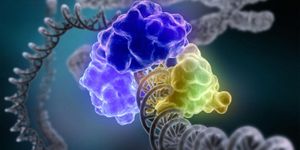How Mitochondria can Help the Cell Fight Pathogens
Drug-resistant microbes are a growing public health threat. One of those pathogens is MRSA, methicillin-resistant Staphylococcus aureus. Researchers at Michigan Medicine wanted to know more about the natural defense mechanisms our bodies use to fight these dangerous microbes. Reporting in Cell Host & Microbe, the scientists learned how one type of immune cell, macrophages, release a deadly payload called reactive oxygen species (ROS), to kill the bacterium. The video below is from the study and shows the process in action.
"One example of a reactive oxygen species is bleach," noted the principal investigator of the report, Mary O'Riordan, Ph.D., a professor of microbiology and immunology at the University of Michigan. "Just like you don't want bleach on your skin, bacteria don't want reactive oxygen to damage their outside surface."
Macrophages can engulf invading microorganisms and trap them in a pocket called a phagosome. Then, the immune cells can release ROS. The mechanism that macrophages use to do so has been established by researchers and has unfortunately also become well-known to some pathogens. Salmonella and MRSA are two examples of bacteria that can evade the macrophage ROS attack.
Led by O'Riordan, a research team including Basel Abuaita, Ph.D., and Tracey Schultz investigated how immune cells then responded to the pathogen's adaptation, and developed another way to kill those bacteria. They were surprised to find a role for a cellular organelle called the mitochondria in that backup plan.
"We discovered that macrophages sense invading MRSA and turn on the machinery to increase mitochondrial development of ROS," Abuaita explained.
Mitochondria act like cellular powerhouses, and they generate ROS as a byproduct of generating energy. When a cell gets stressed, another organelle called the endoplasmic reticulum can signal to the mitochondria to increase ROS production.
Next, the scientists sought to learn how the ROS payload was being sent to the phagosome, where it would destroy the trapped pathogen. "ROS are also damaging to our own cells, so we hypothesized that there must be some delivery mechanism," O'Riordan explained. "Mitochondria have not traditionally been known to package and deliver substances to different parts of the cell."
Using live, high-resolution imaging, the researchers tagged the molecules they were interested in with flourescence and watched the events unfold in real-time. The ROS were being sent in small mitochondrial vesicles. When a cell was infected with MRSA and treated with a dye that glows when it senses ROS, Abuaita saw the infected cell’s mitochondria start to glow. The macrophage also glowed when the bacterium came into contact with it.
After the macrophage consumed the MRSA, there was a glowing hot spot where the ROS was sent to the phagosome. A second method for ROS delivery to the phagosome was confirmed.
"The immune system is full of redundancies," O'Riordan said. "It has to, by definition; every bacteria, virus, or parasite that we know is a pathogen is one because it has evolved ways to avoid the immune system. The immune system also has a real diversity of purpose and mechanism," she added. "Being open to different ways of asking questions about the immune system and understanding the biology of these pathogens helped us to find the right experimental system to use."
Sources: Phys.org via Michigan Medicine - University of Michigan, Cell Host & Microbe








